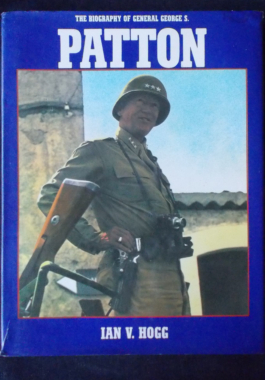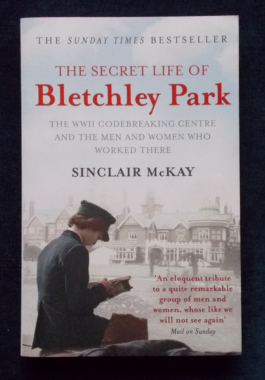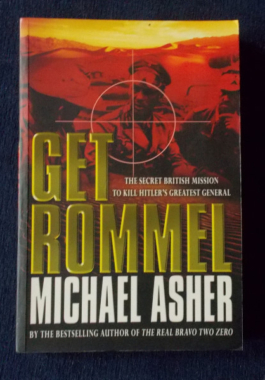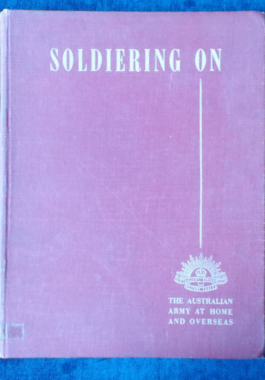Patton's aggression and theatrical personality made his units the most successful and efficient and he believed that it should be his Army that should lead the Allied attacks. This brought him into constant conflict with Eisenhower and Montgomery, with Patton doing nothing to hide his belief that he would win the war if properly supported. He expected the same aggression from his men and was probably the best American field commander in the European theatre.
- Sorry, this product is unavailable.
-

-
 Bletchley Park was where one of Word War II's most famous and crucial achievements was made: the cracking of Germany's Enigma code in which its most important military communications were couched. This country house was home to Britain's most brilliant mathematical brains - including Alan Turing - and the scene of immense advances in technology...indeed, the birth of modern computing. The military codes deciphered there were instrumental in turning both the Battle of the Atlantic and the war in North Africa. Plenty has been written about the scientists and the code-breaking, in both fact and fiction, from Robert Harris and Ian McEwan to Andrew Hodges' biography of Turing. But what of the thousands of men and women who lived and worked there during World War II? This is not only a history of life at Bletchley Park; this is also an amazing compendium of memories from people now in their eighties of skating on the frozen lake in the grounds and the high jinks at nearby accommodation hostels - and of the implacable secrecy that meant girlfriend and boyfriend working in adjacent huts knew nothing about each other's work. Illustrated with black and white photographs.
Bletchley Park was where one of Word War II's most famous and crucial achievements was made: the cracking of Germany's Enigma code in which its most important military communications were couched. This country house was home to Britain's most brilliant mathematical brains - including Alan Turing - and the scene of immense advances in technology...indeed, the birth of modern computing. The military codes deciphered there were instrumental in turning both the Battle of the Atlantic and the war in North Africa. Plenty has been written about the scientists and the code-breaking, in both fact and fiction, from Robert Harris and Ian McEwan to Andrew Hodges' biography of Turing. But what of the thousands of men and women who lived and worked there during World War II? This is not only a history of life at Bletchley Park; this is also an amazing compendium of memories from people now in their eighties of skating on the frozen lake in the grounds and the high jinks at nearby accommodation hostels - and of the implacable secrecy that meant girlfriend and boyfriend working in adjacent huts knew nothing about each other's work. Illustrated with black and white photographs. -
 To many people the most glamorous of aeroplanes is the fighter, by the idea of men flying alone high above the earth in the open cockpit of First World War aircraft, as they fought the gaily-coloured Fokker, Albatross and Pfalz of the German Air Service. This 'feeling for the fighter' was strengthened in 1940 when the Hurricanes and Spitfires of the Royal Air Force saved Britain from German invasion. This book describes the fighters of both wars; there is also the entire development of the fighter from its primitive beginnings up to the supersonic age. The most significant fighters of Britain, France, Germany, Italy, the United States, Japan and the U.S.S.R. are among those featured. Illustrated with black and white photos.
To many people the most glamorous of aeroplanes is the fighter, by the idea of men flying alone high above the earth in the open cockpit of First World War aircraft, as they fought the gaily-coloured Fokker, Albatross and Pfalz of the German Air Service. This 'feeling for the fighter' was strengthened in 1940 when the Hurricanes and Spitfires of the Royal Air Force saved Britain from German invasion. This book describes the fighters of both wars; there is also the entire development of the fighter from its primitive beginnings up to the supersonic age. The most significant fighters of Britain, France, Germany, Italy, the United States, Japan and the U.S.S.R. are among those featured. Illustrated with black and white photos. -

By the summer of 1941 Rommel was Hitler's favourite general. Sent to North Africa to halt the British advance into Libya, he not only stopped the British offensive but drove them back to their Egyptian base. He seemed unbeatable on the field so the British planned to kill him. On the eve of the British offensive Operation Crusader, a specially trained commando team marched into the desert and attacked Rommel's headquarters. At the same time, the newly created SAS parachuted sabotage teams close to the German airfields to knock out the enemy air forces on the ground. The author reveals how poor planning and incompetence in high places was counterbalanced by fantastic bravery and brilliant improvisation that enabled a handful of survivors to escape back to British lines and tell the true story of Operation Flipper: the plot to kill Rommel.
-

 Blitzkrieg: Traces the origins of the war starting with the Armistice at Compiègne in 1919, covering the rise of totalitarianism in Europe, the first terrible months of the Blitzkrieg, the imperialistic aggression of Japan in the Far East, the period of Allied appeasement, the evacuation of Dunkirk and the fall of France. Siege: Begins with the dogged and courageous stand of the British against the onslaught of the Nazi war machine, the war in the North Atlantic and Mediterranean, the invasion of the Balkans and Greece, the harsh and brutal war in the North African desert, the suicidal German attack on Russia, the cruelty of the winter war and the attack on Pearl Harbour. Counterattack: The initial period of the Axis reversals and the first steps on the Allied road to victory; the three great turning points of the war ( Stalingrad, Midway and El Alamein) Rome has fallen; the Nazis are reeling under the Russian counter-offensive and the first of the costly, bloody Pacific campaigns. Victory: The last stages of the war in both the European and Pacific theatres; the Allied landing on the beaches of Normandy, the battle of France, the Red Army offensive, the Yalta conference and the capitulation of the Third Reich, concluding with the bitter Pacific Island campaigns, MacArthur's retrurn to the Philippines, the dropping of the atomic bomb and Japan's surrender. Each volume contains rare photographs; over four volumes, 500 photographs and 100,000 words.
Blitzkrieg: Traces the origins of the war starting with the Armistice at Compiègne in 1919, covering the rise of totalitarianism in Europe, the first terrible months of the Blitzkrieg, the imperialistic aggression of Japan in the Far East, the period of Allied appeasement, the evacuation of Dunkirk and the fall of France. Siege: Begins with the dogged and courageous stand of the British against the onslaught of the Nazi war machine, the war in the North Atlantic and Mediterranean, the invasion of the Balkans and Greece, the harsh and brutal war in the North African desert, the suicidal German attack on Russia, the cruelty of the winter war and the attack on Pearl Harbour. Counterattack: The initial period of the Axis reversals and the first steps on the Allied road to victory; the three great turning points of the war ( Stalingrad, Midway and El Alamein) Rome has fallen; the Nazis are reeling under the Russian counter-offensive and the first of the costly, bloody Pacific campaigns. Victory: The last stages of the war in both the European and Pacific theatres; the Allied landing on the beaches of Normandy, the battle of France, the Red Army offensive, the Yalta conference and the capitulation of the Third Reich, concluding with the bitter Pacific Island campaigns, MacArthur's retrurn to the Philippines, the dropping of the atomic bomb and Japan's surrender. Each volume contains rare photographs; over four volumes, 500 photographs and 100,000 words. -

It was at Dunkirk that Toosey's charisma and fortitude were first noted and in 1941 he was given command of an artillery regiment. Sent to fight in the Far East he and his men were embroiled in the battle for Singapore and were taken prisoner after the island's fall in 1942. The Japanese, scornful of the Allied forces for surrendering, determined to make use of the new workforce now at their disposal. Toosey was sent to Thailand to command the 'bridge camp' at Tamarkan where he was ordered to supervise the construction of two railway bridges over the river Khwae Mae Khlong. Starvation rations and harsh working conditions mean that dysentery and cholera were rife and a quarter of the 60,000 prisoners working on the Burma Railway wold perish. Toosey insisted on high standards of hygiene and discipline, giving back the men their self-respect and making himself a buffer for the cruel excesses if the guards. The author is Toosey's grand-daughter. Illustrated with black and white photographs and sketches.
-

The Holy Fox: Andrew Roberts
$95.00The life of Lord Halifax, remembered as the architect of the policy of achievement of Nazi Germany. His meeting with Hitler in 1937 was a milestone in appeasement yet just days before the 1938 Munich conference, Halifax repudiated the policy and demanded the destruction of Nazism. By May 1940, it was he rather than Churchill who was the choice for Britain's war leader. His public life also included Viceroy of India from 1926 - 31 and a deal with Gandhi that ended the Civil Disobedience campaign before it could force the British to quit. -

 The Australian Army at Home and Overseas, by Some of the Boys and published by the Australian War Memorial, Canberra, 1942. Chapters include: Star Over Bethlehem; Diggers in Britain; Midnight Messiah; Purple's Pup; Arab Justice; Digger v. Doughboy and so much more. Our boys' impressions of Christmas in a cold climate and local customs as well as the American servicemen and women here in Australia. The colour plates, interestingly, are pasted in. Tales, jokes, sketches, cartoons and on-the-spot experiences a-plenty. Illustrated in colour and black and white. A treasure mine of information.
The Australian Army at Home and Overseas, by Some of the Boys and published by the Australian War Memorial, Canberra, 1942. Chapters include: Star Over Bethlehem; Diggers in Britain; Midnight Messiah; Purple's Pup; Arab Justice; Digger v. Doughboy and so much more. Our boys' impressions of Christmas in a cold climate and local customs as well as the American servicemen and women here in Australia. The colour plates, interestingly, are pasted in. Tales, jokes, sketches, cartoons and on-the-spot experiences a-plenty. Illustrated in colour and black and white. A treasure mine of information.




